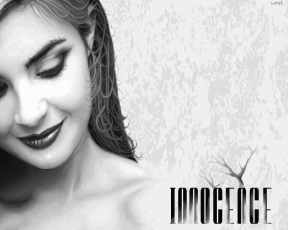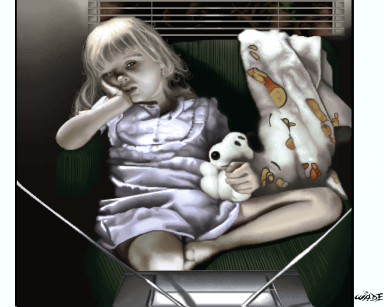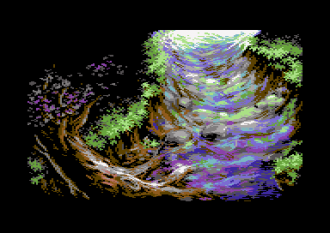Wade: The ART of computer gfx (00.00.1999)
The ART of computer gfx
by Wade/ex-Gods, ex-Nerve Axis
by Wade/ex-Gods, ex-Nerve Axis
It's an easy task to thrust an opinion onto others in way of scene writing. Construct a list of facts to back up a point and then arrange an argument to win support. If done correctly it is even possible to influence the reader and make them think differently in regards to the subject put forward. Other times one may even get a reaction. When this happens, the benefits of debate are clear.
Some people like to criticise the work of others without first hand experience of their cause, to demean the talent of another to feign an intelligent and superior way of thinking. This is no more apparent than in the discussion of art.
In scene terms, this refers to those people who take time to write an article in order to devalue computer illustration. In the eyes of such people, scene graphics, specifically those created with reference, do not conform to their personal interpretation of ART.
One such article could be read in Issue 1 of "The Scene Press", written by AJT/Pulse and Haplo/Zuul Design.
Therefore, this article has been written in defence of scene graphics as art, offering arguments and facts intending to counteract the negativity from conflicting view points.

What is art?
art n. creation of works of beauty.
This is how a common English dictionary would define the meaning of the word `art', but this seems unsatisfactory for some. As scene graphics seldom resemble paintings in a gallery, they will not be considered `real art', because reference is used to reproduce an existing motif, the gfxer has failed to create something.
It is clear from Cougar's high place at TP8 with his scanned oil on canvass creation "X-In Oil" that sceners will judge this way; persuaded by traditional interpretations of art.
However, art does not limit itself to painting, nor to the creation of visual stimuli. Art covers the act of creation and recreation, from acting to writing, to simply combing one's hair.
But here is where the problems arise, opening doors on opinionated debates:
There are stigmas attached to informal art, examples being: graffiti, dance music and in our scene world, computer graphics. An explanation for this is that art has been misconceived as a link between tradition and heritage; valued more with age.
An operatic or ballet performance will attract audiences in their millions, yet a break dancing or skateboard display just doesn`t hold the same prestige. Why? Is it because standing on one's toes requires more effort and dedication than is needed to perform a head spin or double somersault from a halfpipe ramp? Of course not, but there are people who like to associate themselves with circles of seemingly greater intelligence and sophistication. A middle or upper class person such as a politician or company director could never allow himself to be seen in circles of lower class, applauding skateboarders or admiring a mural on a public wall.
It all comes down to image, how a person wishes to be seen by society.
It's an attitude that has started to circulate within the scene. Wannabe art critics in the scene are getting a little too pretentious with time. They claim to see the Emperor's new clothes, they probe the depths of puddles and judge the 4th dimension. It's a case of seeing the non existent to appear wiser than the average person.
Originality and variation is a great thing, even essential to progress, but if one has a true talent for identifying good art, the variation will be apparent in many forms other than those that are most obvious.
Fantasy art, portraits and female figures are just three overused motifs in our scene. Nearly every established gfxer has created such a picture at one time or another. But those that progress and those that can be considered good artists are those who represent the same motif in an original way.
Facet, Danny, Ra, Fairfax and Made. Each of the aforementioned names will conjure an image, an identification of who they were and what they did. Yet, they all copied motifs and all used reference, but are represented by their exclusive, self invented style; from dithering to palette arrangement.
"Most bitmap artists do not CREATE their own pictures. They usually choose a photograph or some kind of already existing picture and translate it into a video screen display." AJT & Haplo.
They may not have invented the motif, but have created the processes used to reproduce it and have conceived a new way of observing the image.
As with ballet and opera, they are re-enacted in the modern world to preserve their appeal. The stage, the performers and in some cases the language is adjusted to suit the audience, to reincarnate the original idea that would otherwise have died alongside the creator.
"It is just some kind of ugly copy job, mainly because we change the medium and lose the interesting aspects of the original piece of art."
The medium has changed, but the qualities haven`t necessarily been lost, just replaced with more adaptable techniques. Instead of brush strokes, the gfxer will use dithering techniques, creating either a gradual flow of colour or a rough textured look. Therefore, they have CREATED these aspects and represented the image in a way which the original artist did not.
An original subject isn`t the only factor in art.
How many times has a landscape been crafted onto canvass? How often has a religious theme dominated an artist's career? And how frequent are portraits in the `real world of art'?
There are very few artists who have constructed an original motif. John Constable, Claude Monet and Leonardo DaVinci are each "guilty" of copying motifs and each used reference to assist their work. The only difference is that they copied from a living subject; a model, a place or a table top arrangement.
Sceners have to adapt to their circumstances. One cannot take their computer to a scenic landscape, neither (despite Louie's claims) is it likely that a mere scene artist can hire a model to pose for him. Therefore, a scener has to use what is available and practical, in the form of magazines, photographs or books that can be picked up and used when inspiration is forthcoming.
Contrary to popular belief, a picture of reference is not an instruction manual. It doesn`t inform the artist of how to blend colours together, to smooth edges or even how to convey the detail by using pixels. One should be able to admire the effort used to recreate an image, the mentally taxing job of translating lines, colours and texture to a screen by means of a mouse. Gfxers have to observe the image in detail, defy the limitations of resolution and the restricted colour. The technique of deluding the onlooker's eye with varied shades, specifically angled lines and curves is an art unto itself. No one can learn this from a photograph, not even the world's best painters.
Another factor to consider when comparing scene gfxers to established painters, is that it can take a famous painter an entire life time to accomplish his/her greatest work, and even they started their career by imitating their idols.
The majority of gfxers in the scene have been painting for no more than ten years, some only five. Look at what they have achieved within this time. Even if they were willing to dedicate their lives to their work, the rewards would not be worth their trouble. A flattering review in a scene mag, the reimbursement of their travel expenses to a party or the prestige of a number 1 spot on the charts. It hardly seems worth it.

Even now, there are gfx artists who will set aside their entire free time, to their computer interest, taking years of their life to learn the techniques to do so, and further years advancing their quality. How insulting it is to read an article by a mere observer stating that their efforts have been wasted, that they haven't created art at all, but some ugly duplication of a photograph.
There are gfxers who still use a motif and produce some awful depictions. Lousy shading, garish colour, smudged outlines and bad proportion are only a few examples of where a gfxer can go wrong. The motif cannot constitute a good picture if the artist lacks talent.
If one does nothing more than add manipulation effects to a scanned picture, it can still be considered art, because the picture has been altered, a new dimension has been created. Of course, this is bad art because little is improvised, and what is new to the picture hasn't required much in the way of vision or effort.
When judging a computer artist, one must be willing to give appropriate credit. The motif, if copied cannot be credited to the gfxer, neither can manipulation effects, scanned palettes and outlines. What the gfxer deserves credit for is everything he created and applied to the screen. Thoughts, technique, mood, colour, composition and perspective, the principles that decide whether the picture looks good or bad.
The more the artist creates himself, the more merit he deserves. A picture or artist cannot be judged by his inspiration alone. Everybody takes inspiration and reference from the more proficient, up until they are the ones serving as inspiration to others. This is what is known as evolution and this is how they exceed the limits.
Comments
